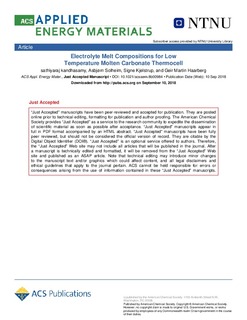Electrolyte Melt Compositions for Low Temperature Molten Carbonate Thermocell
Journal article, Peer reviewed
Accepted version
Permanent lenke
http://hdl.handle.net/11250/2576713Utgivelsesdato
2018Metadata
Vis full innførselSamlinger
- Institutt for kjemi [1394]
- Institutt for materialteknologi [2549]
- Publikasjoner fra CRIStin - NTNU [38127]
Originalversjon
10.1021/acsaem.8b00984Sammendrag
Industrial processes for the production of metals and alloys by metallurgical and electrochemical methods generate a great deal of waste heat due to irreversible losses. This waste heat may be used as a power source to generate electricity. A thermocell with noncritical and inexpensive molten carbonate based electrolyte mixtures with reversible (CO2|O2) gas electrodes was reported recently. It demonstrates the possibility of utilizing the waste heat (>550 °C) as a power source. A thermocell is an electrochemical cell with two identical electrodes placed in an ionic conducting electrolyte solution with a temperature gradient between the electrodes. The heat source will be used to create the temperature gradient between the electrodes, which will lead to a potential difference by executing ionic diffusion in the electrolyte. In this work, the thermophysical and chemical properties of the electrolyte mixture were tuned by multicomponent mixing with molten (K and Ca) carbonate and LiF additives into the binary (Li,Na) carbonate mixture. It reduces the liquidus temperature to ∼400 °C and enables the molten carbonate thermocells to recover the high-grade waste heat available at even low temperatures well below 550 °C. Still, the Seebeck coefficient of the thermocells remains large (in the range of −1.5 mV/K).
